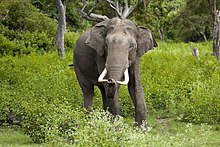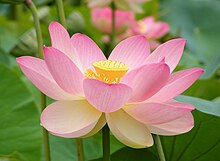Wildlife of India
| Wildlife of India |
|---|
 |
About 24.6% of the total land area is covered by forests. It has various ecosystems ranging from the high altitude
Human encroachment,
Fauna

India has an estimated 92,873 species of fauna, roughly about 7.5% of the species available worldwide.
Many Indian species are descendants of species originating in Gondwana, of which India originally was a part. Peninsular India's subsequent movement towards, and collision with, the Laurasian landmass set off a mass exchange of species. However, volcanism in the Deccan Traps and climatic change 20 million years ago caused the extinction of many endemic Indian forms.[6] Soon thereafter, mammals entered India from Asia through two zoogeographical passes on either side of the emerging Himalayas.[7] As a result, among Indian species, only 12.6% of mammals and 4.5% of birds are endemic, contrasting with 45.8% of reptiles and 55.8% of amphibians[5]
India is home to several well-known large animals, including the
There are about 31 species of aquatic mammals including
Flora

About 24.6% of the total land area is covered by forests.
There are about 29,015 species of plants including 17,926 species of
Conservation
India harbors 172 (2.9%)
Human encroachment,
As of 2023, there are 1022
National symbols
| Symbol | Name | Scientific name | Image | Reference |
|---|---|---|---|---|
| Animal | Bengal tiger | Panthera tigris | 
|
[25] |
| Bird | Indian peafowl | Pavo cristatus | [25] | |
Flower
|
Lotus
|
Nelumbo nucifera | 
|
[26] |
| Tree | Banyan | Ficus benghalensis | [26] | |
| Fruit | Mango | Mangifera indica | 
|
[26] |
| Aquatic animal | Ganges river dolphin | Platanista gangetica | 
|
[27] |
| Heritage animal | Indian elephant | Elephas maximus | 
|
[28] |
| Reptile | King cobra | Ophiophagus hannah | 
|
[28] |
See also
- List of birds of India
- List of mammals of India
- List of reptiles of South Asia
- Wildlife population of India
References
- ^ Stephen, A.; Suresh, R. & Livingstone, C. (2015). "Indian Biodiversity: Past, Present and Future". International Journal of Environment and Natural Sciences. 7: 13–28.
- ^ "Biodiversity Hotspots". CEPF. Retrieved 5 March 2017.
- ^ a b c "List of Species". Government of India. Retrieved 1 December 2023.
- ^ a b c d e f "Fauna of India". Government of India. Retrieved 1 December 2023.
- ^ a b Biodiversity profile for India (Report). United Nations Environmental Programme (UNEP), World Conservation Monitoring Centre. Retrieved 1 December 2023.
- ^ K. Praveen Karach. (2006). Out-of-India Gondwanan origin of some tropical Asian biota (PDF) (Report).
- ^ ISBN 0-00-711062-6.
- ^ Baskaran, N. & Desai, A. A. (1996). "Ranging behaviour of the Asian elephant (Elephas maximus) in the Nilgiri Biosphere Reserve, South India" (PDF). SSC Asian Elephant Specialist Group. 15: 41–57.
- ^ Choudhury, A. U. (1985). "Distribution of Indian one-horned rhinoceros". Tiger Paper. 12 (2): 25–30.
- ^ Jhala, Y. V.; Qureshi, Q.; Nayak, A. K. (2019). Status of tigers, co-predators and prey in India 2018. Summary Report. TR No./2019/05. New Delhi, Dehradun: National Tiger Conservation Authority & Wildlife Institute of India.
- .
- .
- .
- .
- ^ Aquatic mammals of India (PDF) (Report). Marine Biology Regional Centre, Zoological Survey of India. 2011. Retrieved 1 December 2023.
- ^ "7 Rare and Exotic Wildlife Species that can be found in India". 19 June 2015.
- ^ "Animals in Indian Sub-Continent". Archived from the original on 2 March 2022.
- ^ a b "Protected areas". Government of India. Retrieved 1 December 2023.
- ^ "Eco-regions of India". Ecoregion restoration alliance. Retrieved 1 December 2023.
- ^ Manoharachary, C.; Sridhar, K.; Singh, R.; Adholeya, A.; Suryanarayanan, T. S.; Rawat, S. & Johri, B.N. (2005). "Fungal biodiversity: Distribution, conservation and prospecting of fungi from India" (PDF). Current Science. 89 (1). Archived from the original (PDF) on 28 August 2017.
- ^ Fungal biodiversity: Distribution, conservation and prospecting of fungi from India (Report). Retrieved 1 December 2023.
- ^ Groombridge, B. (1993). The 1994 IUCN Red List of Threatened Animals (Report). IUCN. p. 286.
- ^ "India's bird populations 'declining sharply', research shows". 18 February 2020. Retrieved 1 December 2023.
- ISBN 9788170354215.
- ^ a b "National symbols". Government of India. Retrieved 1 December 2023.
- ^ a b c "National symbols of India". Government of India. Retrieved 1 December 2023.
- ^ "Dolphin becomes India's national aquatic animal". Archived from the original on 8 October 2009.
- ^ a b "Significant symbols". The Hindu. 8 August 2011. Retrieved 1 December 2023.
Further reading
- Saravanan, Velayutham. Environmental History of Modern India: Land, Population, Technology and Development (Bloomsbury Publishing India, 2022) online review
- Prasad, S.N.; Ramachanandra, T.V.; Ahalya, N.; Sengupta, T.; Kumar, A.; Tiwari, A.K.; Vijayan, V.S. & Vijayan, L. (2002). "Conservation of wetlands of India – a review". Tropical Ecology. 43 (1): 173–186. CiteSeerX 10.1.1.526.3559.
- Manoharachary, C.; Sridhar, K.; Singh, R.; Adholeya, A.; Suryanarayanan, T. S.; Rawat, S. & Johri, B.N. (2005). "Fungal biodiversity: Distribution, conservation and prospecting of fungi from India" (PDF). Current Science. 89 (1). Archived from the original (PDF) on 28 August 2017.
- Jamaluddin, M.G.; Goswami; B.M. Ojha (2004). Fungi of India 1989–2001. Scientific Publishers. ISBN 8172333544.
External links
- Official website of: Government of India, Ministry of Environment & Forests
- "Legislations on Environment, Forests, and Wildlife" from the Official website of: Government of India, Ministry of Environment & Forests
- "India's Forest Conservation Legislation: Acts, Rules, Guidelines", from the official website of the Government of India, Ministry of Environment & Forests
- Wildlife Legislations, including - "The Indian Wildlife (Protection) Act" from the Official website of: Government of India, Ministry of Environment & Forests
